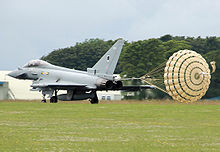This article needs additional citations for verification. (September 2009) |



A drogue parachute, also called drag chute, is a parachute designed for deployment from a rapidly moving object. It can be used for various purposes, such as to decrease speed, to provide control and stability, as a pilot parachute to deploy a larger parachute or a combination of these. Vehicles that have used drogue parachutes include multistage parachutes, aircraft, and spacecraft recovery systems.
The drogue parachute was invented by Russian professor and parachute specialist Gleb Kotelnikov in 1912, who also invented the knapsack parachute. The Soviet Union introduced its first aircraft fitted with drogue parachutes during the mid 1930s; use of the technology expanded during and after the Second World War. A large number of jet-powered aircraft have been furnished with drogue parachutes, including the Boeing B-52 Stratofortress strategic bomber and the Eurofighter Typhoon multirole aircraft; they were also commonly used within crewed space vehicle recovery programmes, including Project Mercury and Project Gemini. The drogue parachute has also been extensively used upon ejection seats as a means of stabilisation and deceleration.